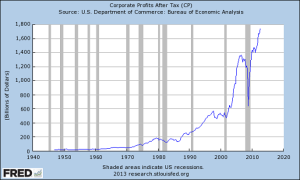All-Time Record Debts Levels to Income Ratio
Imagine this, an approximate 4% US/CAD long bond interest rate yield – and that these rates may not be this high again for two decades, or perhaps even longer. What!?! Does that influence your fear level with regard to experiencing much more in terms of further bond valuation decreases? Pause for a thought if you will.
As with any inter-generational top, a de-leveraging, deflationary, multi-decade depression occurs shortly thereafter – a day where suddenly rates go the other way (triggering instant bond capital gains), maybe all the way back down to 1.25% – 1.75%, or perhaps even negative rates one fine day to push ’em out into the equities… which still may occur so that “Banksters” can enable ever more government money printing (excessive borrowings) to further much needed economic & rigged-market stimuli.
Interesting how often we now suddenly hear, after 150 years, that now all bonds, and all fixed income in general, are suddenly a terrible “sure-to-lose” asset class of investment portfolio construction theory. Especially if rates rise (like rates have never risen before in time it would seem… and why exactly didn’t investors sell ALL their bonds back then when rates did rise and save their bacon?) and so to hell with asset class diversification – let’s go market timing the easy to call, debt market tippy-top instead. Going to a Go-go into “Poof-Proof” paper-based equity issuance is all we hear today. Buy, buy, buy. No sells.
You may have lost an entire year, or even two, worth of interest earned in just over a week in a Bond Fund ETF, but that is the “market’s risk”, and we all agreed long ago not to bother to attempt to “beat” the market; but rather to “join” it. So you take your lumps, and re-balance selling high and buying low for your ultimate investor revenge, but at least you still have your principle to maturity intact… and that is the main point. Risk of capital loss. A true going concern will mature retiring debentures at an accepted agreed upon price at maturity… but your public market paper-printed stock certificates , however, don’t have a maturity price which is likely by design.
, however, don’t have a maturity price which is likely by design.
A less talked about, and different point of view, is maybe somebody really big wants your Bond Portfolio, most if not all of it, and for you to sell it all them at a maximum discount… sell all of yours to them with fear, especially when US 30yr bond trades up around 4.5%. Just a rise of a further 75 bps.., but which this author doubts will be achieved in the near term for reasons to be presented below. The real question about higher rates in this mind is how much higher from “here” and “now” to the rate ceiling debt plateau?
For at present, we know the Central Banksters of the World can’t afford to pay into a new, higher market rate of interest (ie: say a real market rate above 4.75% ) on this record amount (US$ Hundreds of Trillions+++) of notational Bankster QE “record market-making” derivative swap borrowings/money stealing? Gubbermints today can barely afford to “cover” the low “interest-only” carrying costs (& zero principle repayments) but again, only if they can keep rates steady, and again ONLY at record low borrowing rates of interest (ie: under 4.75%) to float these record high loan amounts, for record periods of time, all while stocks remain at, or near record all-time highs. Lots of records being counted upon on a going forward basis it would seem… discounted back from the future cashflows one could expect.
All investments, or assets, are valued for true, good faith negotiated price discovery primarily through using either a dividend discount model, or capital asset pricing model. Both rely on rates of return, and/or rates of interest. Today real estate is priced not upon its intrinsic or absolute value, but rather reverse-engineered financially backwards valuation that is determined by only as what the “Cost to Carry” model states. Low interest rates allow for this flawed model to survive and be accepted by the masses. Cost to Carry models will fail in favour of alt ernative models of financing that will better accept higher rates for modelling price discovery. But, for now… if you’ve got $1999 down and $199/mth, you’ll get use of a $45,000 asset/truck lease for 24 months?If rates do rise anytime soon… not so much truck, and therefore not so much asset can be covered for the same $199 a month.
ernative models of financing that will better accept higher rates for modelling price discovery. But, for now… if you’ve got $1999 down and $199/mth, you’ll get use of a $45,000 asset/truck lease for 24 months?If rates do rise anytime soon… not so much truck, and therefore not so much asset can be covered for the same $199 a month.
Similarly, housing prices are today a matter of carrying costs or to be more blunt, a factor  of your monthly available payment. FV= PV (1+r)n . For if Banks, Re-insurers and Mortgage Lending Pools are the ultimate, true beneficial owners of today’s real estate prices increasing/balance sheet’s asset increasing, then the monthly carrying cost for the average house must not exceed 35%-45% of the average of all wages earned by regulation.
of your monthly available payment. FV= PV (1+r)n . For if Banks, Re-insurers and Mortgage Lending Pools are the ultimate, true beneficial owners of today’s real estate prices increasing/balance sheet’s asset increasing, then the monthly carrying cost for the average house must not exceed 35%-45% of the average of all wages earned by regulation.
Wages don’t seem to be increasing much, if anything part-time is the new full-time. Additionally, if 1% increase in bond rates jumps mortgage rates x 1.4 bps, then qualifying for a higher real estate loan value requires 12% increase in the family income that was once needed at just 2.99% APR. Who got a 12% raise lately?
Therefore, much higher bond rates (say much above 4.5%) will snuff out any Bankster-aided housing recovery embers, and will jeopordize the bankster survival policy of home ownership driving a majority of economic growth and improving those impaired bankster balance sheets along the way.
More likely offshore business and corporate tax laws will be changed to tax (finance some of this low growth taxation) with more global offshore entities paying a little more on new found taxable assets – but at much lowered  domestic tax rates overall. Again, only to the benefit of Bankster-controlled large corporations, who have a record of accumulated offshore wealth (see AAPL), and have patiently waited with hundreds of billions in untaxed offshore earnings warehoused offshore escaping all taxation, until these new lower domestic taxation laws take effect. That’s not tax evasion; it’s just good tax-lobbying for planned tax minimization!
domestic tax rates overall. Again, only to the benefit of Bankster-controlled large corporations, who have a record of accumulated offshore wealth (see AAPL), and have patiently waited with hundreds of billions in untaxed offshore earnings warehoused offshore escaping all taxation, until these new lower domestic taxation laws take effect. That’s not tax evasion; it’s just good tax-lobbying for planned tax minimization!
So in summary, the “push is on” to push the investor class out of from the safety of their protected fixed income/bond positions, as a concerted effort to get title (aka steal) the hard earned and harder to save wealth of the baby-boom generation en mass, for the “Heist of the Century” if you will, by using both the cash, debt and equity markets as a back-door escape mechanism. Beware: the mystical and magical “re-pricing event” using a false-floor equity drop hatch.
by using both the cash, debt and equity markets as a back-door escape mechanism. Beware: the mystical and magical “re-pricing event” using a false-floor equity drop hatch.
By forcing Baby Boomers out from the safety of bonds in this protective, into record higher risk, growth/equities that are/were ramped by the Banksters well back 7 years ago and perhaps forward for 3 or 5 more years further by borrowing ever more, and then leveraging that borrowing 1000:1 to “make the market” of the day seem what it really isn’t … but what about tomorrow… and for how long until one fine re-pricing day well into your retirement?
If you were willing, and then able to steal from anybody, everybody, everywhere, anytime, wouldn’t you wait until the Boomers amassed  exactly the “most accumulated invest-able wealth ever on planet Earth”… and then steal as much as possible, all before the next generation inherits any of what might be left. All of it just might vanish. Instantly. Seemingly overnight. It makes some sense. Makes lots of sense. Too much sense.
exactly the “most accumulated invest-able wealth ever on planet Earth”… and then steal as much as possible, all before the next generation inherits any of what might be left. All of it just might vanish. Instantly. Seemingly overnight. It makes some sense. Makes lots of sense. Too much sense.
So, when is it a gain, the day before you, and your financially-planned early and late to arrive to the party Zoomer friends, plan on not creating anymore active income/billings/earni
gain, the day before you, and your financially-planned early and late to arrive to the party Zoomer friends, plan on not creating anymore active income/billings/earni ngs/more wealth generation again? lol.
ngs/more wealth generation again? lol.
Actionable Investment Thesis/Practical Quarterly Ideas
A recent solution for non-registered (open) taxable bond (XBB-t) type exposure is moving taxable assets over into a new more tax-efficient, risk reduced laddered strip ETF bond product offering, one which wasn’t available back a few years ago, such as BXF-t, which is a managed ETF fixed income ladder of strip bonds which are purchased at discount and that mature at 100%, one every year for five years in essence rolling over forever. Managed by First Asset Trust out of Richmond Hill, Ontario (for no first year fee), it can be used to form a non-registered, taxable core of laddered bonds in a rate-hedged position without much fuss.
BXF-t has more short -term duration & less risk (of under 5yrs) to downside protect bond capital from expected, albeit small rate increases/price fluctuations, which one should surprisingly expect to remain relatively few and far between – and well under a 5% long bond hurdle rate for a very long while yet as will be explained later.
-term duration & less risk (of under 5yrs) to downside protect bond capital from expected, albeit small rate increases/price fluctuations, which one should surprisingly expect to remain relatively few and far between – and well under a 5% long bond hurdle rate for a very long while yet as will be explained later.
Nevertheless, reducing fixed income debt volatility can help us all sleep a little better at nights – so this is what is very interesting and attractive in the fixed income arena at present.
It would be wise to re-balance ones portfolio in early mid-September, after all bond ETF shock statements have been delivered by stress mail, scary panic induces bond mutual funds and ETF selling. This hopefully allows one to sell both the cash and equities classes which are likely higher (re-balancing to buy bonds low/sell equity high). After this recent equity run up/bond & gold run off for example, buying more gold co’s (XGD-t) and (XRE-t) for example along with shorter-term corporate & provincial/government bonds (XBB-t or BXF-t) at these currently higher offered rates of interest (ie: US 30 yr @ 3.75% time of writing) seems contrary and prudent.
Any remaining cash holdings above $10,000 are placed into rolling 90 (or 180/360 day) T-bills (Canadian Federal Government Treasury Bills), and SPECIFICALLY not simply left in the trading cash account position(s) with your bank or broker’s custody, as the broke banker can now legally seize cash left on hand as a “bail-in” at 12:01am some Sunday evening/Monday morning (this includes all Cdn bank accounts according to last Federal Budget p.140).
Therefore, it is a pain… but not leaving much cash lying around; rather investing every dime of cash above $10k and not ever above $100k overnight, or breaching any CDIC limits. Even considering pre-paying lines of credit (LOC) into a large debit positions to avoid “co-mingled bank asset bail-ins” with cash deposits. Creating instead a reverse-engineered credit product, putting one first in line as a segregated, secured, and preferred creditor of the bank instead of being a Bankster’s unsecured investor classes’ trustees claim on reserved co-mingled corporate assets (see PFG).
“co-mingled bank asset bail-ins” with cash deposits. Creating instead a reverse-engineered credit product, putting one first in line as a segregated, secured, and preferred creditor of the bank instead of being a Bankster’s unsecured investor classes’ trustees claim on reserved co-mingled corporate assets (see PFG).
More on this matter later, if you wish…
Hope this gives you a different perspective on things other than as presented by the Bankster’s controlled MSM. Trusting this also helps set the tone for your imminent quarterly portfolio re-balancings.
ContraMan





